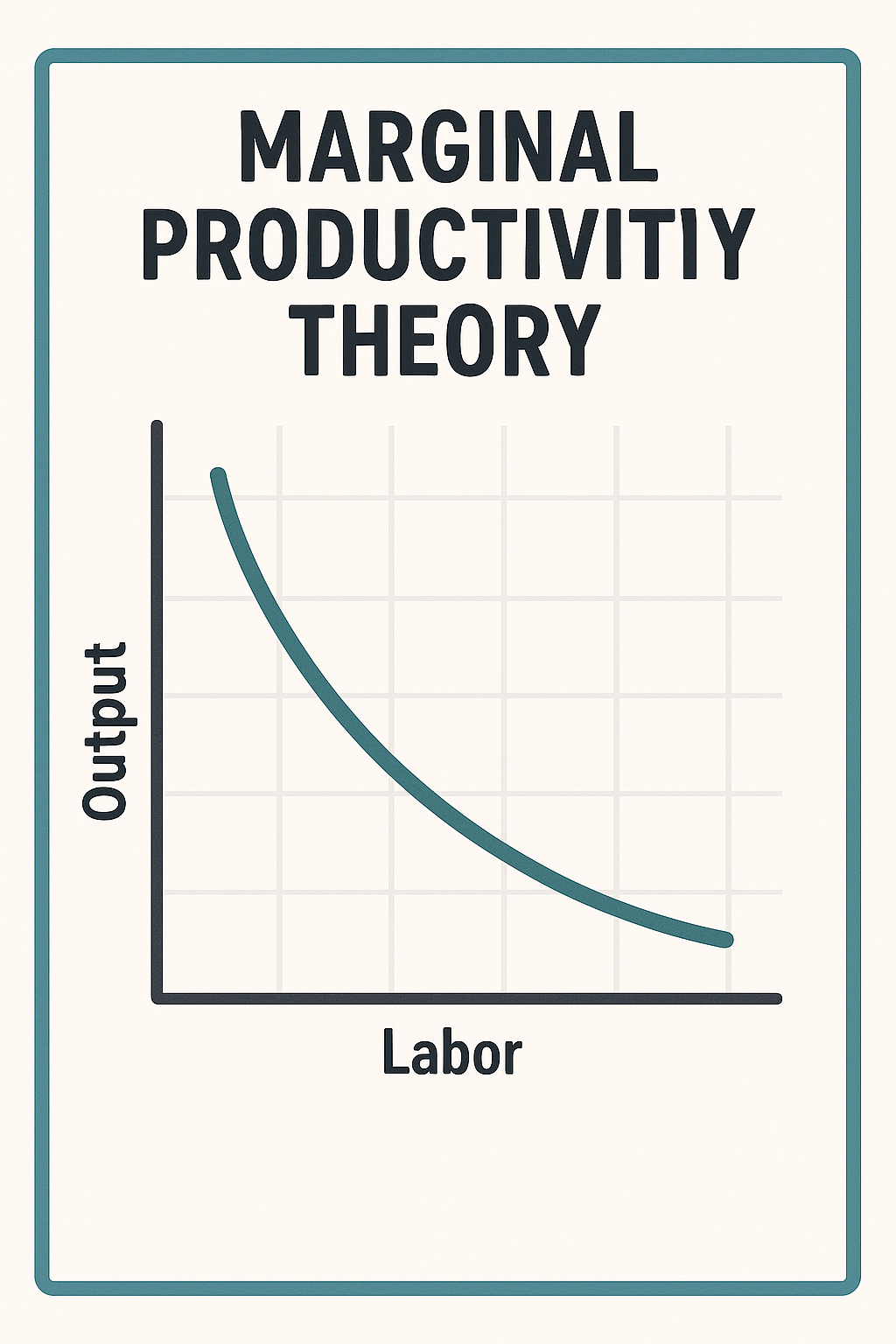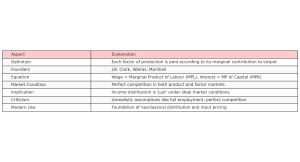
24 Jul Marginal Productivity Theory
Marginal Productivity Theory – UPSC Economics Optional Paper 1
Introduction
The theory of distribution forms the backbone of microeconomic analysis in economics. Among the various distribution theories, the Marginal Productivity Theory is foundational to understanding how the income of different factors of production is determined in a market economy. Originally formulated by J.B. Clark and further refined by economists like Walras and Marshall, this theory asserts that each factor is paid according to its marginal contribution to the production process. This article provides a comprehensive analysis of the theory, its assumptions, applications, criticisms, and relevance to the UPSC CSE exam.
1. What is the Marginal Productivity Theory?
The Marginal Productivity Theory (MPT) explains how income is distributed among the various factors of production—land, labor, capital, and entrepreneurship. It states that the price or reward of any factor is determined by its marginal product—that is, the additional output resulting from one more unit of that input, keeping all other inputs constant.
- Wage = Marginal Product of Labour (MPL)
- Interest = Marginal Product of Capital (MPK)
Under conditions of perfect competition, these marginal products also determine equilibrium prices in the factor markets.
Best economics optional coaching for upsc
2. Historical Background
- J.B. Clark (1899) introduced the concept in his book “The Distribution of Wealth”.
- Léon Walras provided a mathematical general equilibrium framework supporting MPT.
- Alfred Marshall incorporated the theory into his microeconomic partial equilibrium model.
These contributions form the theoretical core of neoclassical distribution theory.
3. Assumptions of the Marginal Productivity Theory
- Perfect competition in product and factor markets
- Homogeneous and divisible factors
- Full employment of all factors
- Perfect substitutability between units of the same factor
- Diminishing marginal returns
These assumptions are often critiqued for being unrealistic in real-world economic systems.
4. Diagrammatic Representation
The equilibrium wage rate is determined at the point where the demand curve for labor (based on MPL) intersects the supply curve.
Similarly, the demand for capital is determined by MPK, and its intersection with the capital supply curve gives the interest rate.
Note: Include a graph in your post using custom visuals for better understanding.
5. Applications
- Used in modern income distribution and taxation policy analysis
- Foundation of input pricing in microeconomics
- Applied in labor economics to determine wage structures
6. Criticisms of Marginal Productivity Theory
- Unrealistic assumptions: Perfect competition, full employment, etc.
- Ignores power dynamics: Bargaining power and institutions are absent.
- Long-run equilibrium only: Doesn’t explain short-run wage/interest disparities.
- Measurement difficulty: It’s hard to isolate the marginal product of a factor in practice.
- Fails in imperfect markets: Monopoly/monopsony distort factor rewards.
7. Modern Extensions and Developments
Although heavily critiqued, MPT still forms the base of many modern distribution theories. Economists like Hicks, Samuelson, and Solow extended MPT to dynamic models:
- Cobb-Douglas Production Function uses MPT to derive constant factor shares.
- Solow Growth Model incorporates MPT to explain long-term economic growth.
- Marginal productivity under monopolistic and monopsonistic competition has been modified to suit imperfect markets.
8. Infographic

Marginal Productivity Theory_Infographic
9. Mind Map

Marginal_Productivity Theory_MindMap
10. Previous Year UPSC Questions (Economics Optional)
- UPSC 2022: Critically examine the Marginal Productivity Theory of distribution.
- UPSC 2019: Explain the contribution of Walras and Clark in distribution theory.
- UPSC 2016: How relevant is the marginal productivity theory in determining modern wage structures?
11. Probable UPSC Questions
- Mains: “Discuss the role of marginal productivity theory in input pricing in a competitive market.”
- Mains: “What are the main limitations of the marginal productivity theory in explaining modern income distribution?”
- Prelims: “According to marginal productivity theory, under perfect competition, a factor is paid…”
- Prelims: “The assumption of diminishing marginal returns is associated with which theory?”
-
Best ias coaching in hindi medium
Best mentorship programme for upsc
12. Conclusion
The Marginal Productivity Theory has stood the test of time as a foundational concept in microeconomics. While its assumptions limit its practical application, the theory continues to inform wage policy, factor pricing, and theoretical models of distribution. For UPSC aspirants, a deep conceptual understanding, along with the ability to critically analyze its assumptions and implications, is key to mastering questions related to distribution theories in Paper 1 of the Economics optional.




No Comments